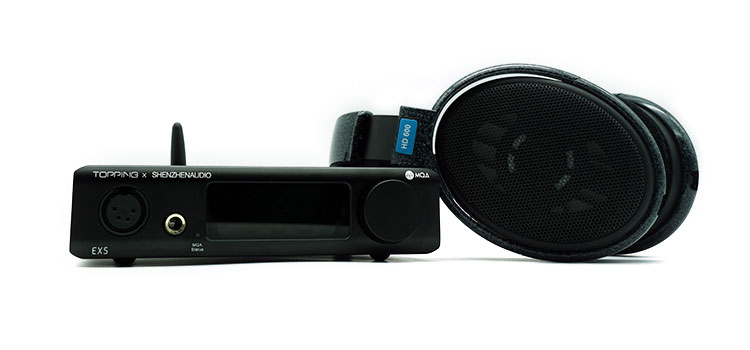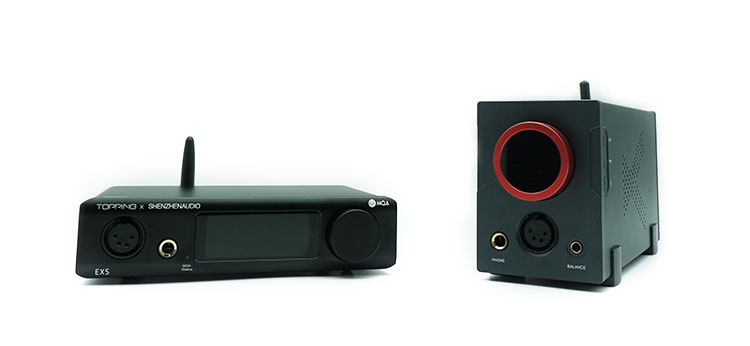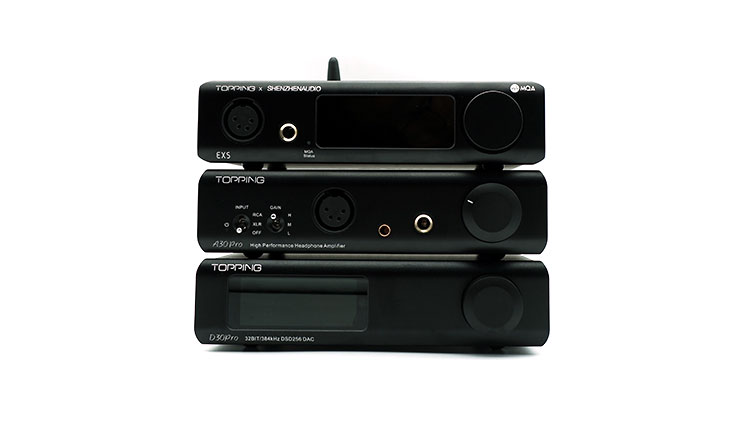Synergy
Power
There are 2 gain levels with the EX5, however, I kept the EX5 at high gain for most of my listening tests. The high gain is silent enough to run IEMs like the FiiO FH3 while having enough power to run my harder-to-drive headphones like my Audio Technica ADX5000, and my Sennheiser HD600.
It also pairs well with planar magnetic headphones like the Audeze LCD-X or the Hifiman Ananda with no real perceived loss in dynamic range from either.
Performance
With the power available on tap with the EX5, it can practically drive a majority of headphones available on the market. However, the less expansive soundstage of the EX5 will not complement some headphones that are already on the more closed-in side of things.
My listening sessions with the EX5 and the LCD-X ended up making me feel that the more closed-in nature of the headphone didn’t complement the EX5’s already less expansive soundscape.
Tonality is also similar between the 2 devices, where they both have an upper midrange and lower treble recession. Doubling down on this quality ended up creating an even drier overall midrange presentation.
Interestingly, while the HD600 is not exactly regarded as a particularly expansive headphone, it complemented the EX5 well. This combination created a generally neutral and fun presentation.
With the mid-bass hump complementing the more subdued mid-bass on the EX5. The richer midrange presentation on the HD600 on the other hand shone through despite the upper midrange recession on the EX5.
Select Comparisons
Xduoo XA-10
Design
Aesthetically, the 2 devices are very different, where the XA-10 is much deeper, while the EX5 takes on a more traditional rectangular shape. While the XA-10 seems to pack everything into a smaller overall package, it has an off-board power supply, which makes it bulkier overall.
Both devices also have an orange LCD screen, however, the XA-10’s display is more informative since the display utilizes pixels that allow it to show letters, instead of a group of 7-segment displays.
Volume adjustment on the XA-10 is done by turning the large red ring on the center of the device, while menu navigation is done using the volume knob and a button on the side that serves as a selection button. Input selection is done using a dedicated input selection button, so overall, the XA-10 has a few extra buttons for ease of navigation.
The available outputs on both devices are also similar, where they both have a single-ended output, as well as a 4-pin balanced XLR output connection. The XA-10 just has an extra 4.4mm pentaconn balanced connection in front.
On the rear of the device, the available digital inputs are the same, which includes an option for USB, coaxial and optical, as well as a screw-on Bluetooth aerial. However, the XA-10 has 2 pairs of single-ended RCA terminals, one which serves as an input, and the other serves as a pre-out. The EX5 in contrast only has pre-amp outputs, both for single-ended RCA and balanced 3-pin XLR.
Technical
Internally, the 2 devices use different DACs to power their DAC sections. The XA-10 uses a pair of AK4493 DAC chips, while the EX5 uses a pair of ES9038Q2M DACs.
However, both devices are equipped with XMOS XU216 USB controllers, which enables both devices to be full MQA decoders, and decode standard PCM files up to 32bit/768kHz and DSD512.
The amplifier section of the 2 devices though is quite different, where the XA-10 is equipped with a class A headphone amplifier section capable of 4W into 32Ω through the balanced outputs, and 3W into 32Ω through the single-ended output.
This is considerably higher than the 1.3W into 32Ω on the EX5. In reality, though, both amplifiers can realistically power all the headphones in my collection.
Performance
Being equipped with different amplifier sections, and DAC sections, the 2 DAC/amps offer contrasting attributes. Where the bass has a more rounded, and smoother presentation when it plays through the XA-10. It offers more of that traditional Class A warmth, while still having the quickness to have an immediate sense of attack.
The midrange on the other hand has a fuller and more romantic character to it. This in turn makes the midrange presentation on the XA-10 comparatively more liquid, and less matter-of-fact. Textures are also a bit less edgy, making the overall details a bit smoother.
The lower treble on the XA-10 is more prominent but still ends up being more glossed over comparatively. The more elevated lower treble region continues onto the upper treble region, allowing the XA-10 to present a bit more air, while not being shrill in a real sense.
The more elevated upper treble range allows the XA-10 to have a more expansive soundstage presentation. However, images formed within the soundstage end up being a bit more blurred together, while having more depth within the soundstage.
The dynamic range ends up being more pronounced with the XA-10, where it has more control over gentler passages, presenting them with more finesse. They are both equally engaging when talking about crescendos though.
Topping A30 Pro & D30 Pro stack
Design
Looking at the Topping A30 Pro/D30 Pro stack, the family resemblance between these 2 devices and the EX5 is unmistakable. The chassis between these 3 devices is pretty much the same, except for some differences in the cutouts, but the composition is pretty much the same. A striking aesthetic difference is that the volume knob on the D30 Pro and A30 Pro is chamfered.
The screen on the EX5 and the D30 Pro is pretty much the same as well, where the numbers and the displays are pretty much the same. The menu system and the remote control used on both devices are also the same, so it’s possible to operate both the EX5 and the D30 Pro using the same remote control.
While the Topping stack ends up being exactly twice the size of the EX5, the A30 Pro/D30 Pro stack ends up having fewer features. The A30 Pro/D30 Pro stack lacks any Bluetooth capability while ending up a bit less convenient since it would require 2 power cables, and interconnection to operate.
In terms of features, I’m just impressed that Topping could just fit all the features of the A30 Pro/D30 Pro and more into the smaller EX5.
Technical
While the chassis looks similar, the USB implementation on the D30 Pro is different, where it features only an XMOS XU208 USB controller. This means that it won’t have MQA decoding capabilities built in.
Furthermore, the D30 Pro has 4 pcs of CS43198 DAC chips in a balanced configuration, which is something rarer than the more standard 2 x ES9038Q2M on the EX5. However, MQA rendering capabilities are glaringly absent on the D30 Pro.
Going into the amp section, the A30 Pro uses the same NFCA amplifier topology that is common among most of the amps produced by Topping. However, the 10 pcs of OPA1656 op-amps operating inside the A30 Pro gives it a more substantial-rated power output maxing out at 6W into 16Ω. This results in being able to power most headphones more comfortably.
Performance
Based on looks, I would have guessed that Topping managed to just cram both the D30 Pro and the A30 Pro into 1 chassis, and created the EX5. However, it’s not that simple. Although there are striking aesthetic similarities, the EX5’s sound signature is unique in itself.
The most striking difference is that the A30 Pro/D30 Pro stack’s midrange is more pushed back while managing to have a richer and more defined midrange presentation.
This allows the vocal range to be more euphonic and liquid. Instrument timbre on the other hand is less planted, however, harmonic overtones are richer, giving instruments a comparatively brighter overall character.
While both systems will reach down into the sub-bass regions, there is a mid-bass bump on the A30 Pro/D30 Pro stack. This mid-bass bump doesn’t translate to bloom though, as the mid-bass remains controlled and rounded, with drum hits having a more immediate sense of attack.
On the A30 Pro/D30 Pro stack, the lower treble is more pushed forward, allowing harmonic overtones to shine through more prominently. However, cymbal hits end up being less crystalline with the stack, since it takes on a smoother overall presentation. The more elevated treble range continues on to the upper treble extension, giving the A30 Pro/D30 Pro stack an airier presentation.
While the soundstage width and imaging definition are about equal on both systems, the layering and separation between the images end up being more defined with the A30 Pro/D30 Pro stack.
This is due in part to the wider dynamic range that the A30 Pro/D30 Pro stack can provide, particularly with portraying softer and gentler tones.
Our Verdict
When I first saw the EX5, I was impressed at how many features Topping has managed to cram into such a small form factor.
Although I would have wanted to see all the features accessible without the external remote control, the EX5 delivers on all fronts in terms of features, and it manages to throw in Bluetooth and full MQA decoding into an already feature-packed device.
Despite creating a feature-packed device in the EX5, Topping still manages to make it sound enjoyable. Combine that with a no-nonsense presentation, the EX5 ensures that the energy in the music is easily conveyed while still being thoroughly honest.
Topping X ShenzhenAudio EX5 Specifications
- USB IN: 1kHz-768kHz/16bit-32bit,
- DSD64-DSD512(Native),
- DSD64-DSD256(Dop)
- Renderer, MQA Studio, MQA
- OPT/ COAX IN: 1kHz-192kHz/16bit-24bit, DSD64(Dop)
- BT IN: AAC/SBC/APTX/APTX LL/APTX HD/LDAC
- Headphone Amplifier section:
- THD + N: <0.0003% (32Ω, balanced XLR)
- <0.00010%(32Ω, single-ended RCA)
- SNR: 125dB
- Gain: 6dB(low gain)
- 15dB(high gain)
- Output power: 3W x2 @ 32Ω
- 140mW x2 @ 300Ω





